Feminism: History, Social Practice, and Domestic Violence
VerifiedAdded on 2021/01/02
|11
|3871
|222
Report
AI Summary
This report provides a comprehensive overview of feminism, encompassing its historical evolution, social practices, and its critical intersection with domestic violence. The introduction defines feminism as a movement advocating for gender equality. The main body delves into the three waves of feminism, highlighting key events, figures, and the changing focus of the movement, from suffrage to broader social issues like reproductive rights and workplace equality. The report then explores feminist social practice, linking it to domestic violence, analyzing how feminist principles are applied in social work, and discussing strategies to combat violence against women. It examines the role of gender inequality in perpetuating domestic violence and emphasizes the importance of intersectionality and multicultural frameworks in feminist practice. The report concludes by summarizing the key findings and the ongoing relevance of feminism in addressing contemporary social issues.

THEORY
Paraphrase This Document
Need a fresh take? Get an instant paraphrase of this document with our AI Paraphraser
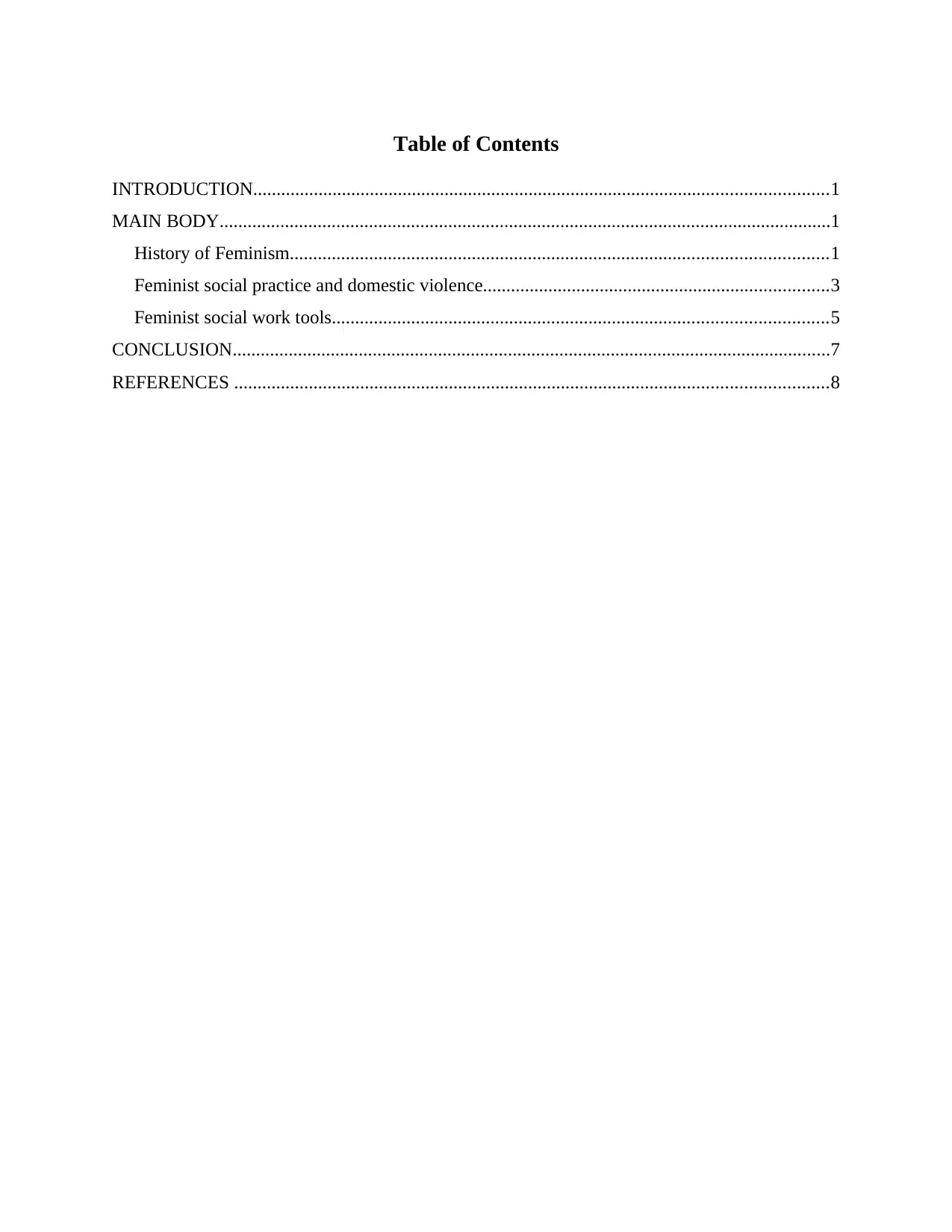
Table of Contents
INTRODUCTION...........................................................................................................................1
MAIN BODY...................................................................................................................................1
History of Feminism...................................................................................................................1
Feminist social practice and domestic violence..........................................................................3
Feminist social work tools..........................................................................................................5
CONCLUSION................................................................................................................................7
REFERENCES ...............................................................................................................................8
INTRODUCTION...........................................................................................................................1
MAIN BODY...................................................................................................................................1
History of Feminism...................................................................................................................1
Feminist social practice and domestic violence..........................................................................3
Feminist social work tools..........................................................................................................5
CONCLUSION................................................................................................................................7
REFERENCES ...............................................................................................................................8
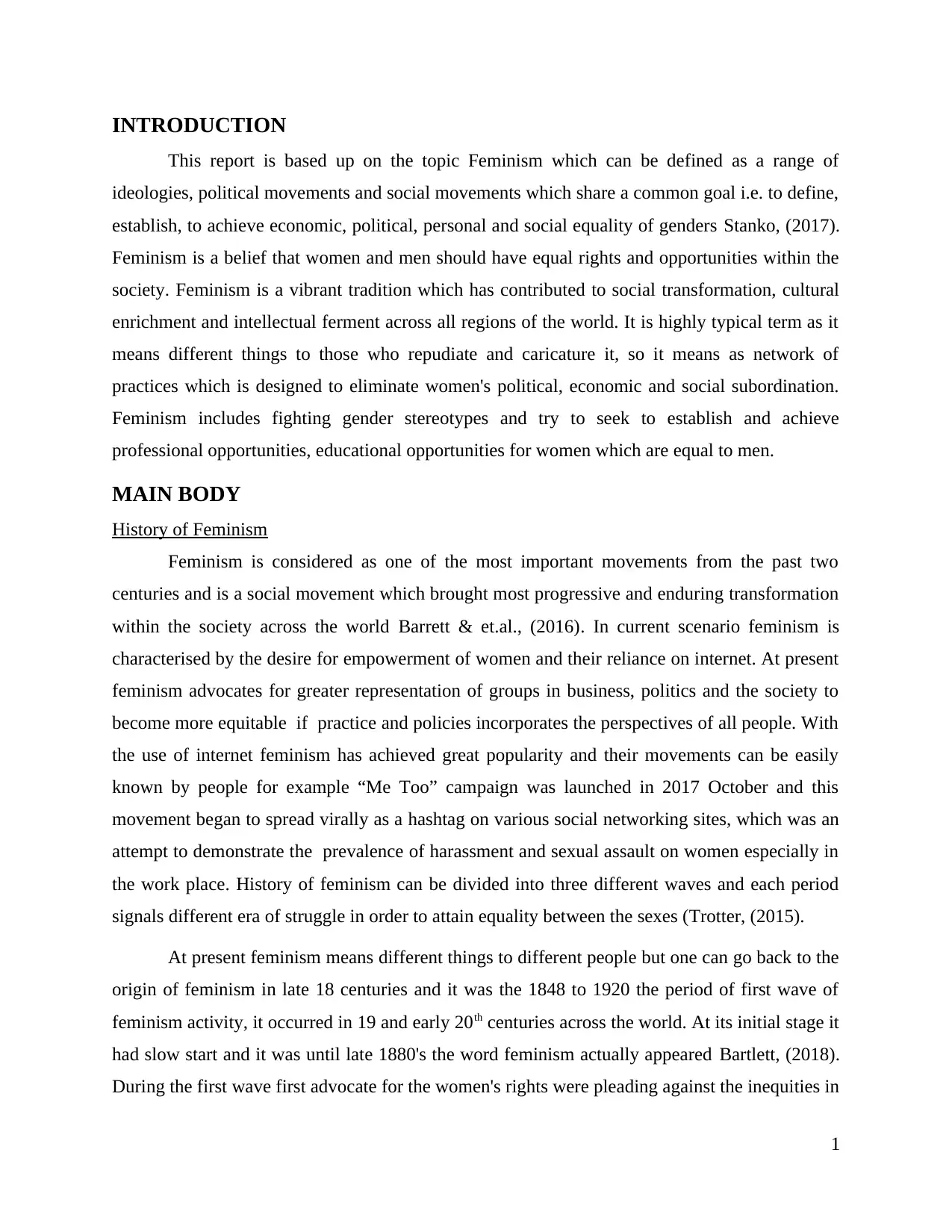
INTRODUCTION
This report is based up on the topic Feminism which can be defined as a range of
ideologies, political movements and social movements which share a common goal i.e. to define,
establish, to achieve economic, political, personal and social equality of genders Stanko, (2017).
Feminism is a belief that women and men should have equal rights and opportunities within the
society. Feminism is a vibrant tradition which has contributed to social transformation, cultural
enrichment and intellectual ferment across all regions of the world. It is highly typical term as it
means different things to those who repudiate and caricature it, so it means as network of
practices which is designed to eliminate women's political, economic and social subordination.
Feminism includes fighting gender stereotypes and try to seek to establish and achieve
professional opportunities, educational opportunities for women which are equal to men.
MAIN BODY
History of Feminism
Feminism is considered as one of the most important movements from the past two
centuries and is a social movement which brought most progressive and enduring transformation
within the society across the world Barrett & et.al., (2016). In current scenario feminism is
characterised by the desire for empowerment of women and their reliance on internet. At present
feminism advocates for greater representation of groups in business, politics and the society to
become more equitable if practice and policies incorporates the perspectives of all people. With
the use of internet feminism has achieved great popularity and their movements can be easily
known by people for example “Me Too” campaign was launched in 2017 October and this
movement began to spread virally as a hashtag on various social networking sites, which was an
attempt to demonstrate the prevalence of harassment and sexual assault on women especially in
the work place. History of feminism can be divided into three different waves and each period
signals different era of struggle in order to attain equality between the sexes (Trotter, (2015).
At present feminism means different things to different people but one can go back to the
origin of feminism in late 18 centuries and it was the 1848 to 1920 the period of first wave of
feminism activity, it occurred in 19 and early 20th centuries across the world. At its initial stage it
had slow start and it was until late 1880's the word feminism actually appeared Bartlett, (2018).
During the first wave first advocate for the women's rights were pleading against the inequities in
1
This report is based up on the topic Feminism which can be defined as a range of
ideologies, political movements and social movements which share a common goal i.e. to define,
establish, to achieve economic, political, personal and social equality of genders Stanko, (2017).
Feminism is a belief that women and men should have equal rights and opportunities within the
society. Feminism is a vibrant tradition which has contributed to social transformation, cultural
enrichment and intellectual ferment across all regions of the world. It is highly typical term as it
means different things to those who repudiate and caricature it, so it means as network of
practices which is designed to eliminate women's political, economic and social subordination.
Feminism includes fighting gender stereotypes and try to seek to establish and achieve
professional opportunities, educational opportunities for women which are equal to men.
MAIN BODY
History of Feminism
Feminism is considered as one of the most important movements from the past two
centuries and is a social movement which brought most progressive and enduring transformation
within the society across the world Barrett & et.al., (2016). In current scenario feminism is
characterised by the desire for empowerment of women and their reliance on internet. At present
feminism advocates for greater representation of groups in business, politics and the society to
become more equitable if practice and policies incorporates the perspectives of all people. With
the use of internet feminism has achieved great popularity and their movements can be easily
known by people for example “Me Too” campaign was launched in 2017 October and this
movement began to spread virally as a hashtag on various social networking sites, which was an
attempt to demonstrate the prevalence of harassment and sexual assault on women especially in
the work place. History of feminism can be divided into three different waves and each period
signals different era of struggle in order to attain equality between the sexes (Trotter, (2015).
At present feminism means different things to different people but one can go back to the
origin of feminism in late 18 centuries and it was the 1848 to 1920 the period of first wave of
feminism activity, it occurred in 19 and early 20th centuries across the world. At its initial stage it
had slow start and it was until late 1880's the word feminism actually appeared Bartlett, (2018).
During the first wave first advocate for the women's rights were pleading against the inequities in
1
⊘ This is a preview!⊘
Do you want full access?
Subscribe today to unlock all pages.

Trusted by 1+ million students worldwide
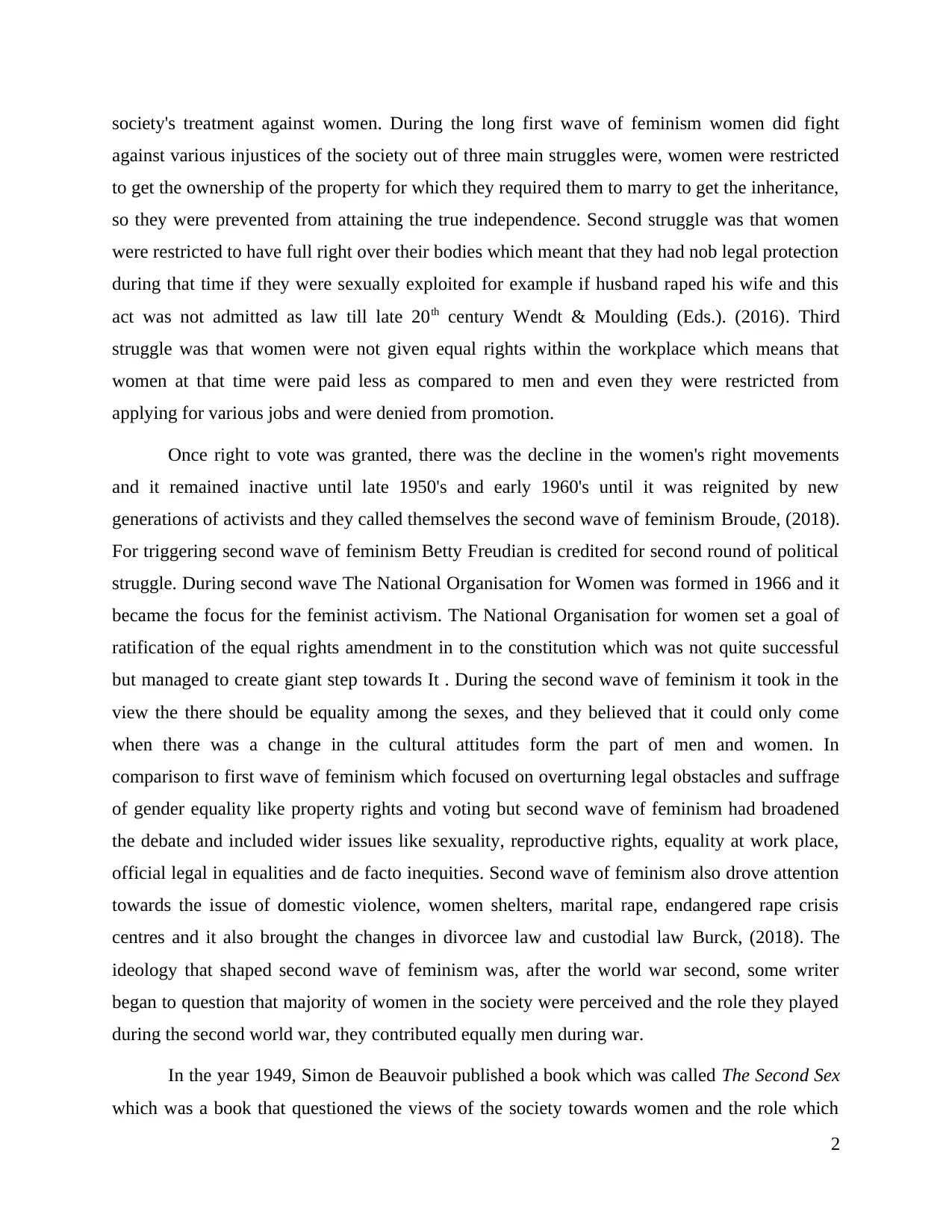
society's treatment against women. During the long first wave of feminism women did fight
against various injustices of the society out of three main struggles were, women were restricted
to get the ownership of the property for which they required them to marry to get the inheritance,
so they were prevented from attaining the true independence. Second struggle was that women
were restricted to have full right over their bodies which meant that they had nob legal protection
during that time if they were sexually exploited for example if husband raped his wife and this
act was not admitted as law till late 20th century Wendt & Moulding (Eds.). (2016). Third
struggle was that women were not given equal rights within the workplace which means that
women at that time were paid less as compared to men and even they were restricted from
applying for various jobs and were denied from promotion.
Once right to vote was granted, there was the decline in the women's right movements
and it remained inactive until late 1950's and early 1960's until it was reignited by new
generations of activists and they called themselves the second wave of feminism Broude, (2018).
For triggering second wave of feminism Betty Freudian is credited for second round of political
struggle. During second wave The National Organisation for Women was formed in 1966 and it
became the focus for the feminist activism. The National Organisation for women set a goal of
ratification of the equal rights amendment in to the constitution which was not quite successful
but managed to create giant step towards It . During the second wave of feminism it took in the
view the there should be equality among the sexes, and they believed that it could only come
when there was a change in the cultural attitudes form the part of men and women. In
comparison to first wave of feminism which focused on overturning legal obstacles and suffrage
of gender equality like property rights and voting but second wave of feminism had broadened
the debate and included wider issues like sexuality, reproductive rights, equality at work place,
official legal in equalities and de facto inequities. Second wave of feminism also drove attention
towards the issue of domestic violence, women shelters, marital rape, endangered rape crisis
centres and it also brought the changes in divorcee law and custodial law Burck, (2018). The
ideology that shaped second wave of feminism was, after the world war second, some writer
began to question that majority of women in the society were perceived and the role they played
during the second world war, they contributed equally men during war.
In the year 1949, Simon de Beauvoir published a book which was called The Second Sex
which was a book that questioned the views of the society towards women and the role which
2
against various injustices of the society out of three main struggles were, women were restricted
to get the ownership of the property for which they required them to marry to get the inheritance,
so they were prevented from attaining the true independence. Second struggle was that women
were restricted to have full right over their bodies which meant that they had nob legal protection
during that time if they were sexually exploited for example if husband raped his wife and this
act was not admitted as law till late 20th century Wendt & Moulding (Eds.). (2016). Third
struggle was that women were not given equal rights within the workplace which means that
women at that time were paid less as compared to men and even they were restricted from
applying for various jobs and were denied from promotion.
Once right to vote was granted, there was the decline in the women's right movements
and it remained inactive until late 1950's and early 1960's until it was reignited by new
generations of activists and they called themselves the second wave of feminism Broude, (2018).
For triggering second wave of feminism Betty Freudian is credited for second round of political
struggle. During second wave The National Organisation for Women was formed in 1966 and it
became the focus for the feminist activism. The National Organisation for women set a goal of
ratification of the equal rights amendment in to the constitution which was not quite successful
but managed to create giant step towards It . During the second wave of feminism it took in the
view the there should be equality among the sexes, and they believed that it could only come
when there was a change in the cultural attitudes form the part of men and women. In
comparison to first wave of feminism which focused on overturning legal obstacles and suffrage
of gender equality like property rights and voting but second wave of feminism had broadened
the debate and included wider issues like sexuality, reproductive rights, equality at work place,
official legal in equalities and de facto inequities. Second wave of feminism also drove attention
towards the issue of domestic violence, women shelters, marital rape, endangered rape crisis
centres and it also brought the changes in divorcee law and custodial law Burck, (2018). The
ideology that shaped second wave of feminism was, after the world war second, some writer
began to question that majority of women in the society were perceived and the role they played
during the second world war, they contributed equally men during war.
In the year 1949, Simon de Beauvoir published a book which was called The Second Sex
which was a book that questioned the views of the society towards women and the role which
2
Paraphrase This Document
Need a fresh take? Get an instant paraphrase of this document with our AI Paraphraser
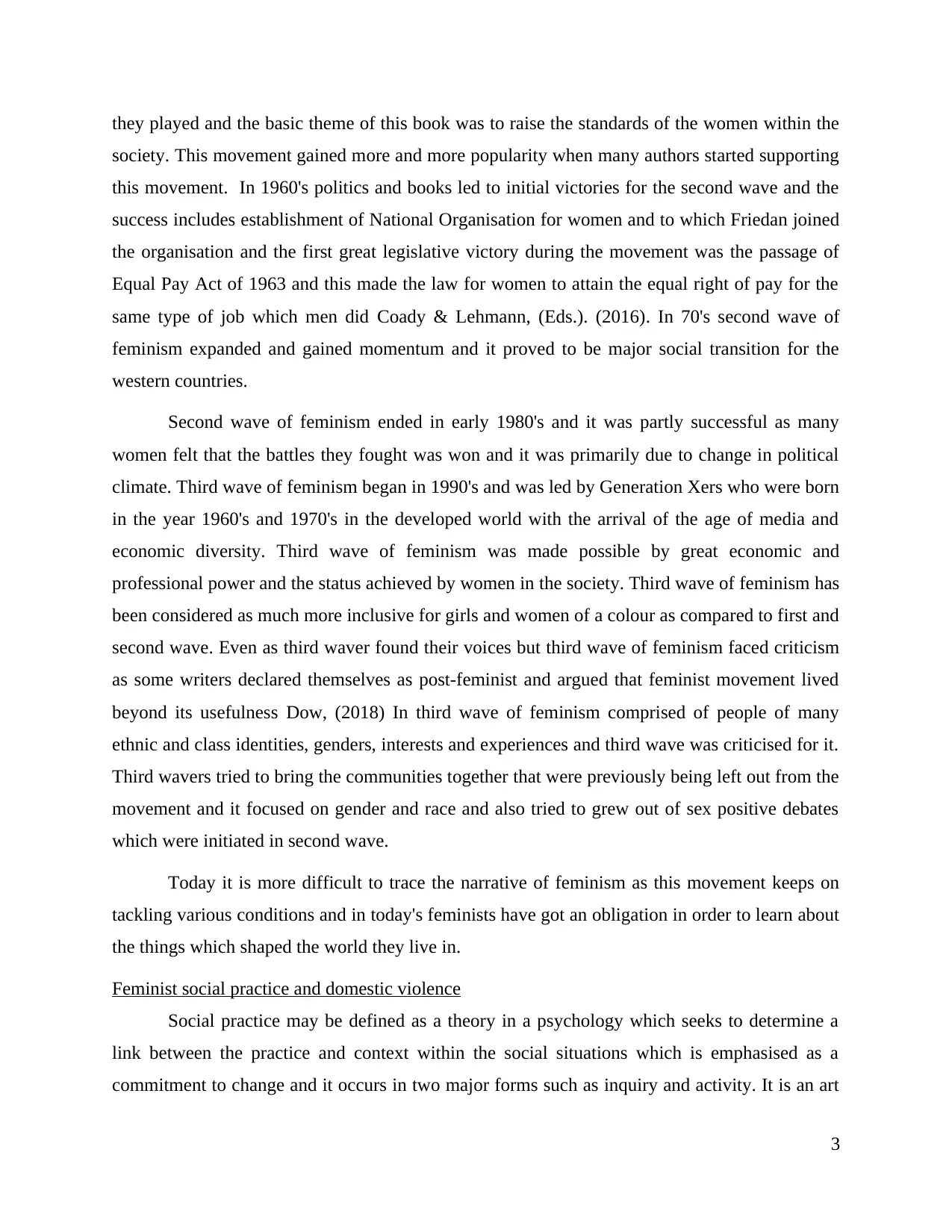
they played and the basic theme of this book was to raise the standards of the women within the
society. This movement gained more and more popularity when many authors started supporting
this movement. In 1960's politics and books led to initial victories for the second wave and the
success includes establishment of National Organisation for women and to which Friedan joined
the organisation and the first great legislative victory during the movement was the passage of
Equal Pay Act of 1963 and this made the law for women to attain the equal right of pay for the
same type of job which men did Coady & Lehmann, (Eds.). (2016). In 70's second wave of
feminism expanded and gained momentum and it proved to be major social transition for the
western countries.
Second wave of feminism ended in early 1980's and it was partly successful as many
women felt that the battles they fought was won and it was primarily due to change in political
climate. Third wave of feminism began in 1990's and was led by Generation Xers who were born
in the year 1960's and 1970's in the developed world with the arrival of the age of media and
economic diversity. Third wave of feminism was made possible by great economic and
professional power and the status achieved by women in the society. Third wave of feminism has
been considered as much more inclusive for girls and women of a colour as compared to first and
second wave. Even as third waver found their voices but third wave of feminism faced criticism
as some writers declared themselves as post-feminist and argued that feminist movement lived
beyond its usefulness Dow, (2018) In third wave of feminism comprised of people of many
ethnic and class identities, genders, interests and experiences and third wave was criticised for it.
Third wavers tried to bring the communities together that were previously being left out from the
movement and it focused on gender and race and also tried to grew out of sex positive debates
which were initiated in second wave.
Today it is more difficult to trace the narrative of feminism as this movement keeps on
tackling various conditions and in today's feminists have got an obligation in order to learn about
the things which shaped the world they live in.
Feminist social practice and domestic violence
Social practice may be defined as a theory in a psychology which seeks to determine a
link between the practice and context within the social situations which is emphasised as a
commitment to change and it occurs in two major forms such as inquiry and activity. It is an art
3
society. This movement gained more and more popularity when many authors started supporting
this movement. In 1960's politics and books led to initial victories for the second wave and the
success includes establishment of National Organisation for women and to which Friedan joined
the organisation and the first great legislative victory during the movement was the passage of
Equal Pay Act of 1963 and this made the law for women to attain the equal right of pay for the
same type of job which men did Coady & Lehmann, (Eds.). (2016). In 70's second wave of
feminism expanded and gained momentum and it proved to be major social transition for the
western countries.
Second wave of feminism ended in early 1980's and it was partly successful as many
women felt that the battles they fought was won and it was primarily due to change in political
climate. Third wave of feminism began in 1990's and was led by Generation Xers who were born
in the year 1960's and 1970's in the developed world with the arrival of the age of media and
economic diversity. Third wave of feminism was made possible by great economic and
professional power and the status achieved by women in the society. Third wave of feminism has
been considered as much more inclusive for girls and women of a colour as compared to first and
second wave. Even as third waver found their voices but third wave of feminism faced criticism
as some writers declared themselves as post-feminist and argued that feminist movement lived
beyond its usefulness Dow, (2018) In third wave of feminism comprised of people of many
ethnic and class identities, genders, interests and experiences and third wave was criticised for it.
Third wavers tried to bring the communities together that were previously being left out from the
movement and it focused on gender and race and also tried to grew out of sex positive debates
which were initiated in second wave.
Today it is more difficult to trace the narrative of feminism as this movement keeps on
tackling various conditions and in today's feminists have got an obligation in order to learn about
the things which shaped the world they live in.
Feminist social practice and domestic violence
Social practice may be defined as a theory in a psychology which seeks to determine a
link between the practice and context within the social situations which is emphasised as a
commitment to change and it occurs in two major forms such as inquiry and activity. It is an art
3
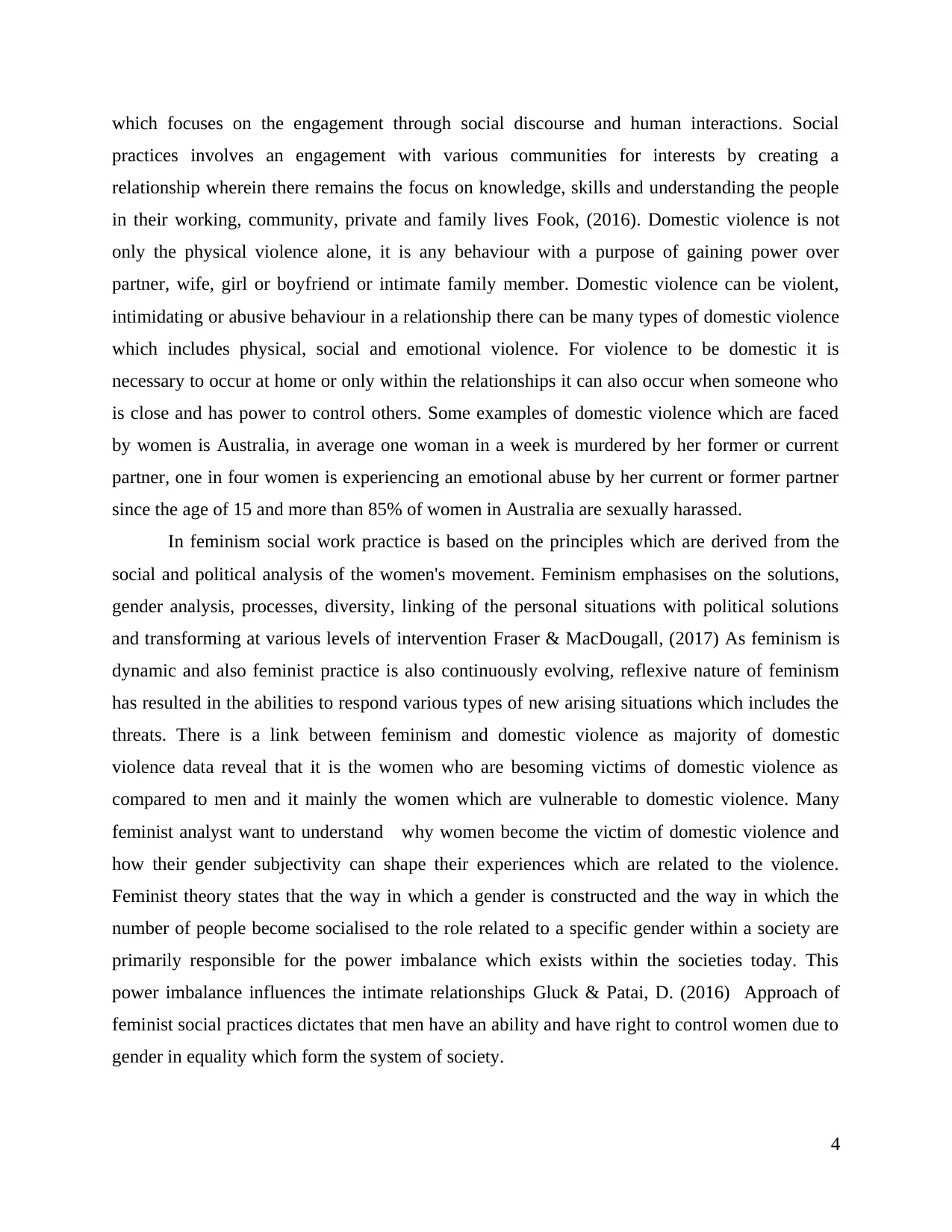
which focuses on the engagement through social discourse and human interactions. Social
practices involves an engagement with various communities for interests by creating a
relationship wherein there remains the focus on knowledge, skills and understanding the people
in their working, community, private and family lives Fook, (2016). Domestic violence is not
only the physical violence alone, it is any behaviour with a purpose of gaining power over
partner, wife, girl or boyfriend or intimate family member. Domestic violence can be violent,
intimidating or abusive behaviour in a relationship there can be many types of domestic violence
which includes physical, social and emotional violence. For violence to be domestic it is
necessary to occur at home or only within the relationships it can also occur when someone who
is close and has power to control others. Some examples of domestic violence which are faced
by women is Australia, in average one woman in a week is murdered by her former or current
partner, one in four women is experiencing an emotional abuse by her current or former partner
since the age of 15 and more than 85% of women in Australia are sexually harassed.
In feminism social work practice is based on the principles which are derived from the
social and political analysis of the women's movement. Feminism emphasises on the solutions,
gender analysis, processes, diversity, linking of the personal situations with political solutions
and transforming at various levels of intervention Fraser & MacDougall, (2017) As feminism is
dynamic and also feminist practice is also continuously evolving, reflexive nature of feminism
has resulted in the abilities to respond various types of new arising situations which includes the
threats. There is a link between feminism and domestic violence as majority of domestic
violence data reveal that it is the women who are besoming victims of domestic violence as
compared to men and it mainly the women which are vulnerable to domestic violence. Many
feminist analyst want to understand why women become the victim of domestic violence and
how their gender subjectivity can shape their experiences which are related to the violence.
Feminist theory states that the way in which a gender is constructed and the way in which the
number of people become socialised to the role related to a specific gender within a society are
primarily responsible for the power imbalance which exists within the societies today. This
power imbalance influences the intimate relationships Gluck & Patai, D. (2016) Approach of
feminist social practices dictates that men have an ability and have right to control women due to
gender in equality which form the system of society.
4
practices involves an engagement with various communities for interests by creating a
relationship wherein there remains the focus on knowledge, skills and understanding the people
in their working, community, private and family lives Fook, (2016). Domestic violence is not
only the physical violence alone, it is any behaviour with a purpose of gaining power over
partner, wife, girl or boyfriend or intimate family member. Domestic violence can be violent,
intimidating or abusive behaviour in a relationship there can be many types of domestic violence
which includes physical, social and emotional violence. For violence to be domestic it is
necessary to occur at home or only within the relationships it can also occur when someone who
is close and has power to control others. Some examples of domestic violence which are faced
by women is Australia, in average one woman in a week is murdered by her former or current
partner, one in four women is experiencing an emotional abuse by her current or former partner
since the age of 15 and more than 85% of women in Australia are sexually harassed.
In feminism social work practice is based on the principles which are derived from the
social and political analysis of the women's movement. Feminism emphasises on the solutions,
gender analysis, processes, diversity, linking of the personal situations with political solutions
and transforming at various levels of intervention Fraser & MacDougall, (2017) As feminism is
dynamic and also feminist practice is also continuously evolving, reflexive nature of feminism
has resulted in the abilities to respond various types of new arising situations which includes the
threats. There is a link between feminism and domestic violence as majority of domestic
violence data reveal that it is the women who are besoming victims of domestic violence as
compared to men and it mainly the women which are vulnerable to domestic violence. Many
feminist analyst want to understand why women become the victim of domestic violence and
how their gender subjectivity can shape their experiences which are related to the violence.
Feminist theory states that the way in which a gender is constructed and the way in which the
number of people become socialised to the role related to a specific gender within a society are
primarily responsible for the power imbalance which exists within the societies today. This
power imbalance influences the intimate relationships Gluck & Patai, D. (2016) Approach of
feminist social practices dictates that men have an ability and have right to control women due to
gender in equality which form the system of society.
4
⊘ This is a preview!⊘
Do you want full access?
Subscribe today to unlock all pages.

Trusted by 1+ million students worldwide
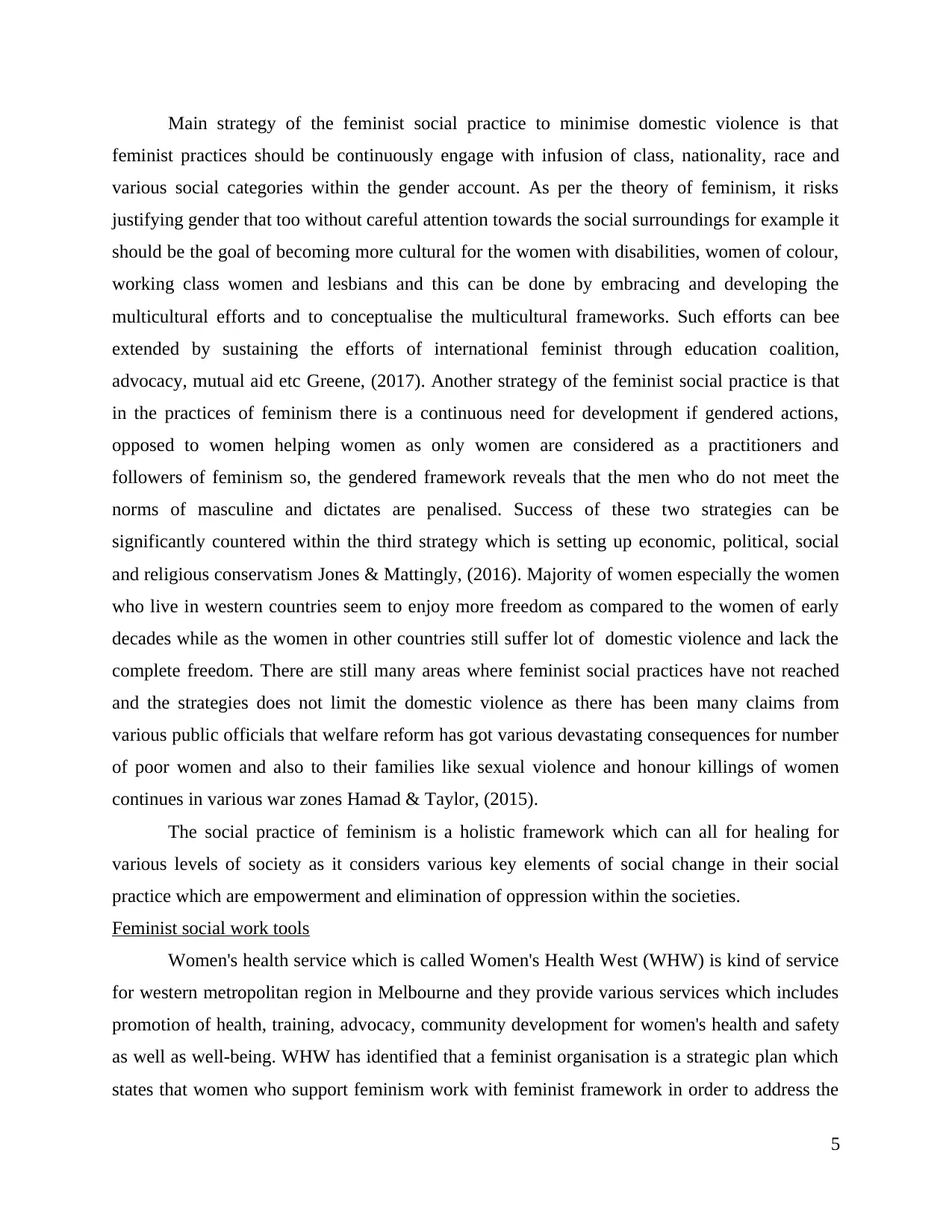
Main strategy of the feminist social practice to minimise domestic violence is that
feminist practices should be continuously engage with infusion of class, nationality, race and
various social categories within the gender account. As per the theory of feminism, it risks
justifying gender that too without careful attention towards the social surroundings for example it
should be the goal of becoming more cultural for the women with disabilities, women of colour,
working class women and lesbians and this can be done by embracing and developing the
multicultural efforts and to conceptualise the multicultural frameworks. Such efforts can bee
extended by sustaining the efforts of international feminist through education coalition,
advocacy, mutual aid etc Greene, (2017). Another strategy of the feminist social practice is that
in the practices of feminism there is a continuous need for development if gendered actions,
opposed to women helping women as only women are considered as a practitioners and
followers of feminism so, the gendered framework reveals that the men who do not meet the
norms of masculine and dictates are penalised. Success of these two strategies can be
significantly countered within the third strategy which is setting up economic, political, social
and religious conservatism Jones & Mattingly, (2016). Majority of women especially the women
who live in western countries seem to enjoy more freedom as compared to the women of early
decades while as the women in other countries still suffer lot of domestic violence and lack the
complete freedom. There are still many areas where feminist social practices have not reached
and the strategies does not limit the domestic violence as there has been many claims from
various public officials that welfare reform has got various devastating consequences for number
of poor women and also to their families like sexual violence and honour killings of women
continues in various war zones Hamad & Taylor, (2015).
The social practice of feminism is a holistic framework which can all for healing for
various levels of society as it considers various key elements of social change in their social
practice which are empowerment and elimination of oppression within the societies.
Feminist social work tools
Women's health service which is called Women's Health West (WHW) is kind of service
for western metropolitan region in Melbourne and they provide various services which includes
promotion of health, training, advocacy, community development for women's health and safety
as well as well-being. WHW has identified that a feminist organisation is a strategic plan which
states that women who support feminism work with feminist framework in order to address the
5
feminist practices should be continuously engage with infusion of class, nationality, race and
various social categories within the gender account. As per the theory of feminism, it risks
justifying gender that too without careful attention towards the social surroundings for example it
should be the goal of becoming more cultural for the women with disabilities, women of colour,
working class women and lesbians and this can be done by embracing and developing the
multicultural efforts and to conceptualise the multicultural frameworks. Such efforts can bee
extended by sustaining the efforts of international feminist through education coalition,
advocacy, mutual aid etc Greene, (2017). Another strategy of the feminist social practice is that
in the practices of feminism there is a continuous need for development if gendered actions,
opposed to women helping women as only women are considered as a practitioners and
followers of feminism so, the gendered framework reveals that the men who do not meet the
norms of masculine and dictates are penalised. Success of these two strategies can be
significantly countered within the third strategy which is setting up economic, political, social
and religious conservatism Jones & Mattingly, (2016). Majority of women especially the women
who live in western countries seem to enjoy more freedom as compared to the women of early
decades while as the women in other countries still suffer lot of domestic violence and lack the
complete freedom. There are still many areas where feminist social practices have not reached
and the strategies does not limit the domestic violence as there has been many claims from
various public officials that welfare reform has got various devastating consequences for number
of poor women and also to their families like sexual violence and honour killings of women
continues in various war zones Hamad & Taylor, (2015).
The social practice of feminism is a holistic framework which can all for healing for
various levels of society as it considers various key elements of social change in their social
practice which are empowerment and elimination of oppression within the societies.
Feminist social work tools
Women's health service which is called Women's Health West (WHW) is kind of service
for western metropolitan region in Melbourne and they provide various services which includes
promotion of health, training, advocacy, community development for women's health and safety
as well as well-being. WHW has identified that a feminist organisation is a strategic plan which
states that women who support feminism work with feminist framework in order to address the
5
Paraphrase This Document
Need a fresh take? Get an instant paraphrase of this document with our AI Paraphraser
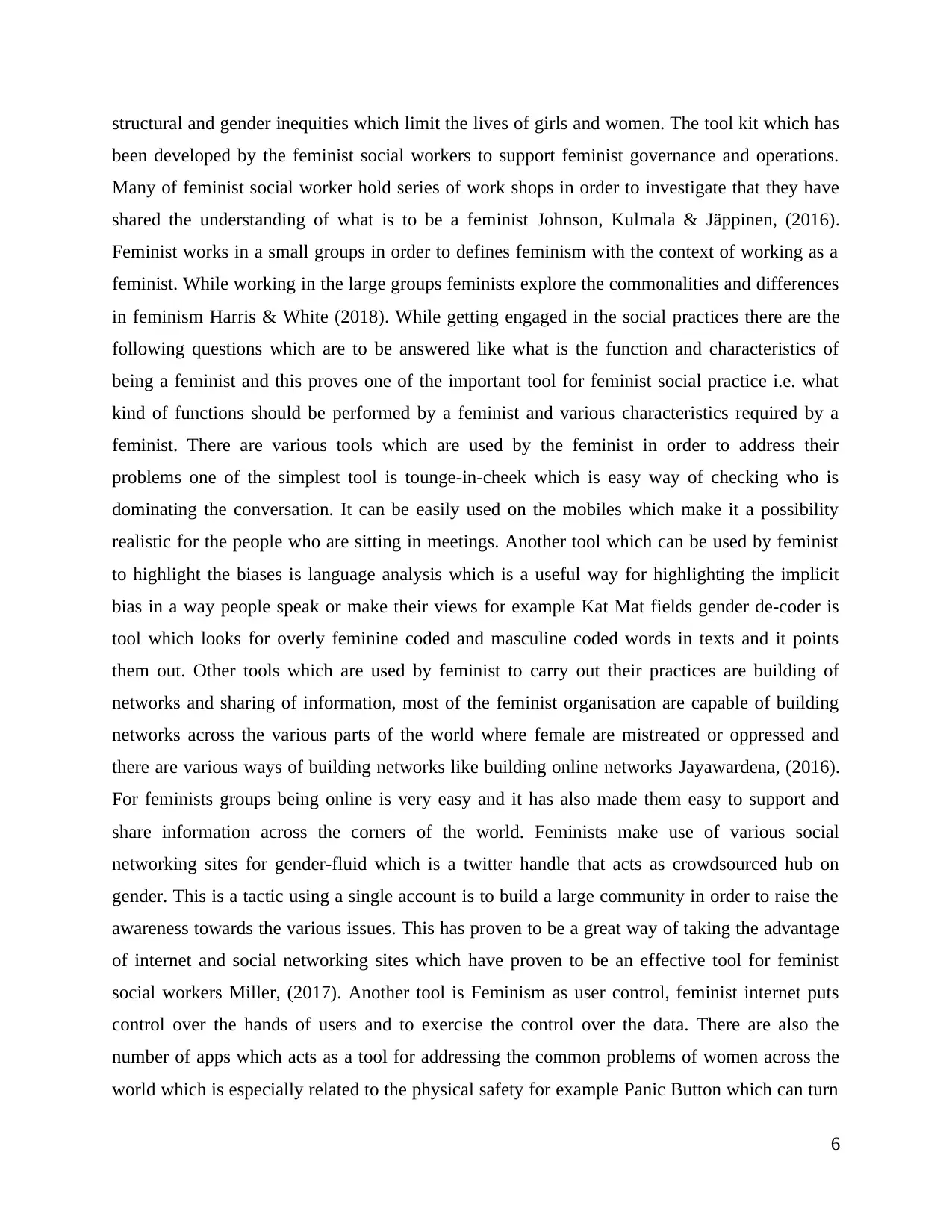
structural and gender inequities which limit the lives of girls and women. The tool kit which has
been developed by the feminist social workers to support feminist governance and operations.
Many of feminist social worker hold series of work shops in order to investigate that they have
shared the understanding of what is to be a feminist Johnson, Kulmala & Jäppinen, (2016).
Feminist works in a small groups in order to defines feminism with the context of working as a
feminist. While working in the large groups feminists explore the commonalities and differences
in feminism Harris & White (2018). While getting engaged in the social practices there are the
following questions which are to be answered like what is the function and characteristics of
being a feminist and this proves one of the important tool for feminist social practice i.e. what
kind of functions should be performed by a feminist and various characteristics required by a
feminist. There are various tools which are used by the feminist in order to address their
problems one of the simplest tool is tounge-in-cheek which is easy way of checking who is
dominating the conversation. It can be easily used on the mobiles which make it a possibility
realistic for the people who are sitting in meetings. Another tool which can be used by feminist
to highlight the biases is language analysis which is a useful way for highlighting the implicit
bias in a way people speak or make their views for example Kat Mat fields gender de-coder is
tool which looks for overly feminine coded and masculine coded words in texts and it points
them out. Other tools which are used by feminist to carry out their practices are building of
networks and sharing of information, most of the feminist organisation are capable of building
networks across the various parts of the world where female are mistreated or oppressed and
there are various ways of building networks like building online networks Jayawardena, (2016).
For feminists groups being online is very easy and it has also made them easy to support and
share information across the corners of the world. Feminists make use of various social
networking sites for gender-fluid which is a twitter handle that acts as crowdsourced hub on
gender. This is a tactic using a single account is to build a large community in order to raise the
awareness towards the various issues. This has proven to be a great way of taking the advantage
of internet and social networking sites which have proven to be an effective tool for feminist
social workers Miller, (2017). Another tool is Feminism as user control, feminist internet puts
control over the hands of users and to exercise the control over the data. There are also the
number of apps which acts as a tool for addressing the common problems of women across the
world which is especially related to the physical safety for example Panic Button which can turn
6
been developed by the feminist social workers to support feminist governance and operations.
Many of feminist social worker hold series of work shops in order to investigate that they have
shared the understanding of what is to be a feminist Johnson, Kulmala & Jäppinen, (2016).
Feminist works in a small groups in order to defines feminism with the context of working as a
feminist. While working in the large groups feminists explore the commonalities and differences
in feminism Harris & White (2018). While getting engaged in the social practices there are the
following questions which are to be answered like what is the function and characteristics of
being a feminist and this proves one of the important tool for feminist social practice i.e. what
kind of functions should be performed by a feminist and various characteristics required by a
feminist. There are various tools which are used by the feminist in order to address their
problems one of the simplest tool is tounge-in-cheek which is easy way of checking who is
dominating the conversation. It can be easily used on the mobiles which make it a possibility
realistic for the people who are sitting in meetings. Another tool which can be used by feminist
to highlight the biases is language analysis which is a useful way for highlighting the implicit
bias in a way people speak or make their views for example Kat Mat fields gender de-coder is
tool which looks for overly feminine coded and masculine coded words in texts and it points
them out. Other tools which are used by feminist to carry out their practices are building of
networks and sharing of information, most of the feminist organisation are capable of building
networks across the various parts of the world where female are mistreated or oppressed and
there are various ways of building networks like building online networks Jayawardena, (2016).
For feminists groups being online is very easy and it has also made them easy to support and
share information across the corners of the world. Feminists make use of various social
networking sites for gender-fluid which is a twitter handle that acts as crowdsourced hub on
gender. This is a tactic using a single account is to build a large community in order to raise the
awareness towards the various issues. This has proven to be a great way of taking the advantage
of internet and social networking sites which have proven to be an effective tool for feminist
social workers Miller, (2017). Another tool is Feminism as user control, feminist internet puts
control over the hands of users and to exercise the control over the data. There are also the
number of apps which acts as a tool for addressing the common problems of women across the
world which is especially related to the physical safety for example Panic Button which can turn
6
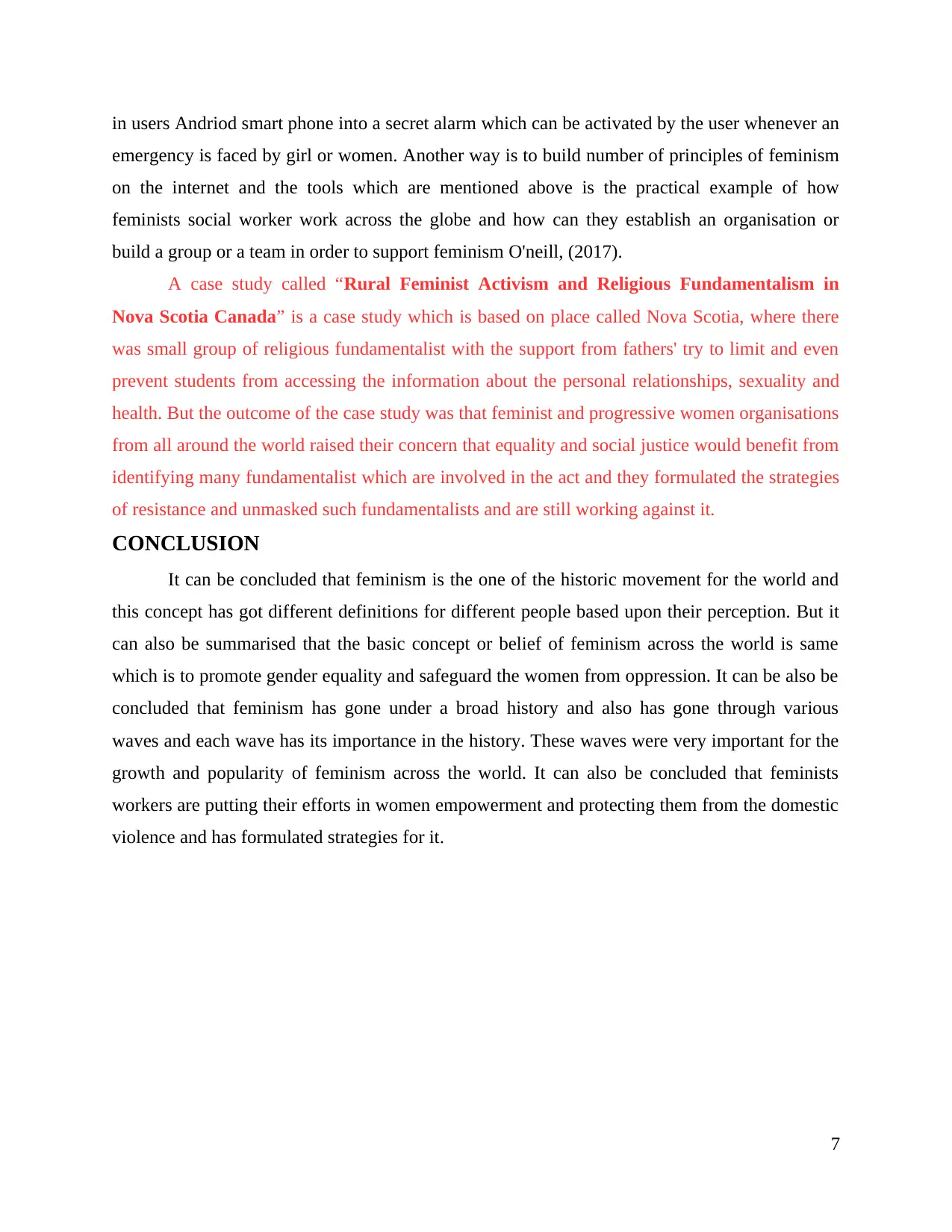
in users Andriod smart phone into a secret alarm which can be activated by the user whenever an
emergency is faced by girl or women. Another way is to build number of principles of feminism
on the internet and the tools which are mentioned above is the practical example of how
feminists social worker work across the globe and how can they establish an organisation or
build a group or a team in order to support feminism O'neill, (2017).
A case study called “Rural Feminist Activism and Religious Fundamentalism in
Nova Scotia Canada” is a case study which is based on place called Nova Scotia, where there
was small group of religious fundamentalist with the support from fathers' try to limit and even
prevent students from accessing the information about the personal relationships, sexuality and
health. But the outcome of the case study was that feminist and progressive women organisations
from all around the world raised their concern that equality and social justice would benefit from
identifying many fundamentalist which are involved in the act and they formulated the strategies
of resistance and unmasked such fundamentalists and are still working against it.
CONCLUSION
It can be concluded that feminism is the one of the historic movement for the world and
this concept has got different definitions for different people based upon their perception. But it
can also be summarised that the basic concept or belief of feminism across the world is same
which is to promote gender equality and safeguard the women from oppression. It can be also be
concluded that feminism has gone under a broad history and also has gone through various
waves and each wave has its importance in the history. These waves were very important for the
growth and popularity of feminism across the world. It can also be concluded that feminists
workers are putting their efforts in women empowerment and protecting them from the domestic
violence and has formulated strategies for it.
7
emergency is faced by girl or women. Another way is to build number of principles of feminism
on the internet and the tools which are mentioned above is the practical example of how
feminists social worker work across the globe and how can they establish an organisation or
build a group or a team in order to support feminism O'neill, (2017).
A case study called “Rural Feminist Activism and Religious Fundamentalism in
Nova Scotia Canada” is a case study which is based on place called Nova Scotia, where there
was small group of religious fundamentalist with the support from fathers' try to limit and even
prevent students from accessing the information about the personal relationships, sexuality and
health. But the outcome of the case study was that feminist and progressive women organisations
from all around the world raised their concern that equality and social justice would benefit from
identifying many fundamentalist which are involved in the act and they formulated the strategies
of resistance and unmasked such fundamentalists and are still working against it.
CONCLUSION
It can be concluded that feminism is the one of the historic movement for the world and
this concept has got different definitions for different people based upon their perception. But it
can also be summarised that the basic concept or belief of feminism across the world is same
which is to promote gender equality and safeguard the women from oppression. It can be also be
concluded that feminism has gone under a broad history and also has gone through various
waves and each wave has its importance in the history. These waves were very important for the
growth and popularity of feminism across the world. It can also be concluded that feminists
workers are putting their efforts in women empowerment and protecting them from the domestic
violence and has formulated strategies for it.
7
⊘ This is a preview!⊘
Do you want full access?
Subscribe today to unlock all pages.

Trusted by 1+ million students worldwide
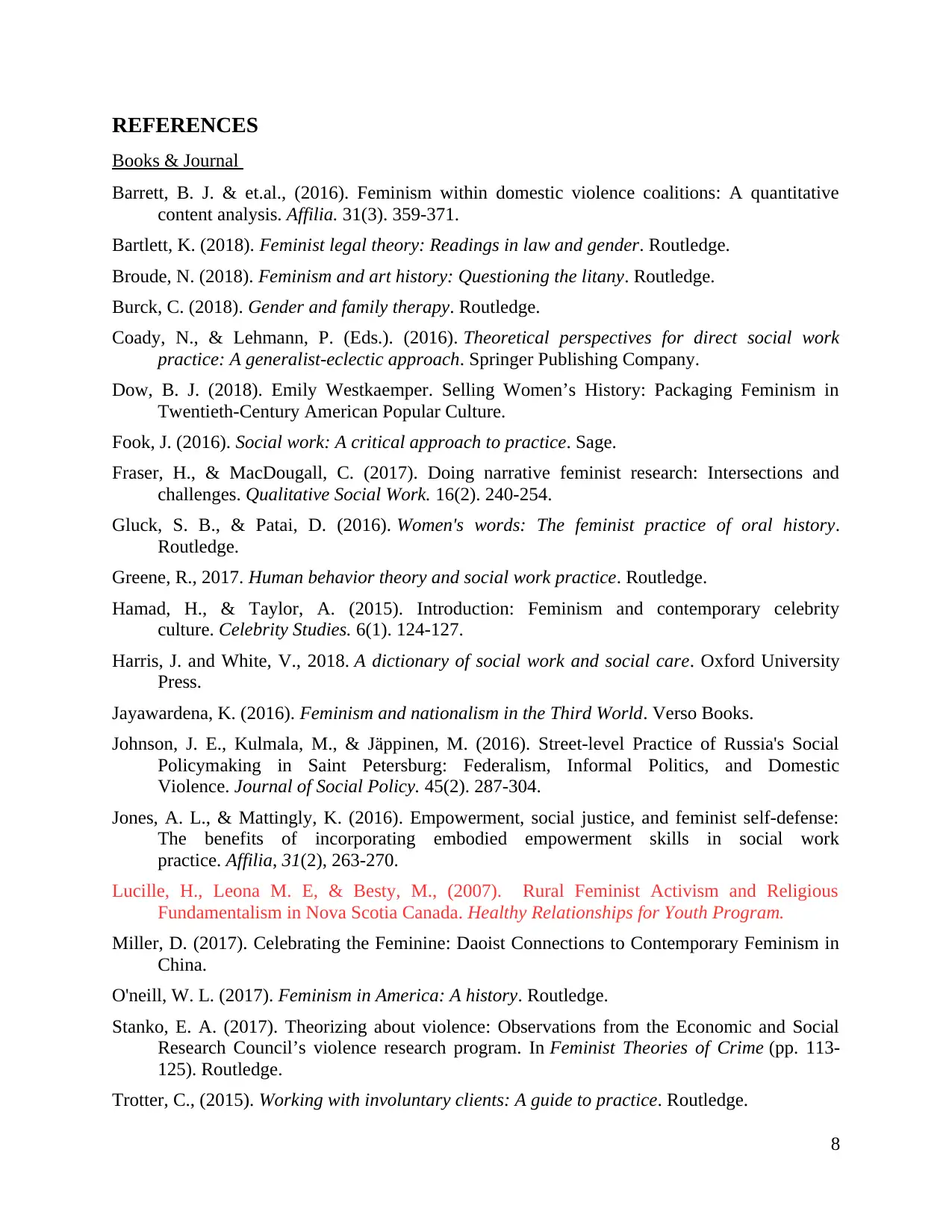
REFERENCES
Books & Journal
Barrett, B. J. & et.al., (2016). Feminism within domestic violence coalitions: A quantitative
content analysis. Affilia. 31(3). 359-371.
Bartlett, K. (2018). Feminist legal theory: Readings in law and gender. Routledge.
Broude, N. (2018). Feminism and art history: Questioning the litany. Routledge.
Burck, C. (2018). Gender and family therapy. Routledge.
Coady, N., & Lehmann, P. (Eds.). (2016). Theoretical perspectives for direct social work
practice: A generalist-eclectic approach. Springer Publishing Company.
Dow, B. J. (2018). Emily Westkaemper. Selling Women’s History: Packaging Feminism in
Twentieth-Century American Popular Culture.
Fook, J. (2016). Social work: A critical approach to practice. Sage.
Fraser, H., & MacDougall, C. (2017). Doing narrative feminist research: Intersections and
challenges. Qualitative Social Work. 16(2). 240-254.
Gluck, S. B., & Patai, D. (2016). Women's words: The feminist practice of oral history.
Routledge.
Greene, R., 2017. Human behavior theory and social work practice. Routledge.
Hamad, H., & Taylor, A. (2015). Introduction: Feminism and contemporary celebrity
culture. Celebrity Studies. 6(1). 124-127.
Harris, J. and White, V., 2018. A dictionary of social work and social care. Oxford University
Press.
Jayawardena, K. (2016). Feminism and nationalism in the Third World. Verso Books.
Johnson, J. E., Kulmala, M., & Jäppinen, M. (2016). Street-level Practice of Russia's Social
Policymaking in Saint Petersburg: Federalism, Informal Politics, and Domestic
Violence. Journal of Social Policy. 45(2). 287-304.
Jones, A. L., & Mattingly, K. (2016). Empowerment, social justice, and feminist self-defense:
The benefits of incorporating embodied empowerment skills in social work
practice. Affilia, 31(2), 263-270.
Lucille, H., Leona M. E, & Besty, M., (2007). Rural Feminist Activism and Religious
Fundamentalism in Nova Scotia Canada. Healthy Relationships for Youth Program.
Miller, D. (2017). Celebrating the Feminine: Daoist Connections to Contemporary Feminism in
China.
O'neill, W. L. (2017). Feminism in America: A history. Routledge.
Stanko, E. A. (2017). Theorizing about violence: Observations from the Economic and Social
Research Council’s violence research program. In Feminist Theories of Crime (pp. 113-
125). Routledge.
Trotter, C., (2015). Working with involuntary clients: A guide to practice. Routledge.
8
Books & Journal
Barrett, B. J. & et.al., (2016). Feminism within domestic violence coalitions: A quantitative
content analysis. Affilia. 31(3). 359-371.
Bartlett, K. (2018). Feminist legal theory: Readings in law and gender. Routledge.
Broude, N. (2018). Feminism and art history: Questioning the litany. Routledge.
Burck, C. (2018). Gender and family therapy. Routledge.
Coady, N., & Lehmann, P. (Eds.). (2016). Theoretical perspectives for direct social work
practice: A generalist-eclectic approach. Springer Publishing Company.
Dow, B. J. (2018). Emily Westkaemper. Selling Women’s History: Packaging Feminism in
Twentieth-Century American Popular Culture.
Fook, J. (2016). Social work: A critical approach to practice. Sage.
Fraser, H., & MacDougall, C. (2017). Doing narrative feminist research: Intersections and
challenges. Qualitative Social Work. 16(2). 240-254.
Gluck, S. B., & Patai, D. (2016). Women's words: The feminist practice of oral history.
Routledge.
Greene, R., 2017. Human behavior theory and social work practice. Routledge.
Hamad, H., & Taylor, A. (2015). Introduction: Feminism and contemporary celebrity
culture. Celebrity Studies. 6(1). 124-127.
Harris, J. and White, V., 2018. A dictionary of social work and social care. Oxford University
Press.
Jayawardena, K. (2016). Feminism and nationalism in the Third World. Verso Books.
Johnson, J. E., Kulmala, M., & Jäppinen, M. (2016). Street-level Practice of Russia's Social
Policymaking in Saint Petersburg: Federalism, Informal Politics, and Domestic
Violence. Journal of Social Policy. 45(2). 287-304.
Jones, A. L., & Mattingly, K. (2016). Empowerment, social justice, and feminist self-defense:
The benefits of incorporating embodied empowerment skills in social work
practice. Affilia, 31(2), 263-270.
Lucille, H., Leona M. E, & Besty, M., (2007). Rural Feminist Activism and Religious
Fundamentalism in Nova Scotia Canada. Healthy Relationships for Youth Program.
Miller, D. (2017). Celebrating the Feminine: Daoist Connections to Contemporary Feminism in
China.
O'neill, W. L. (2017). Feminism in America: A history. Routledge.
Stanko, E. A. (2017). Theorizing about violence: Observations from the Economic and Social
Research Council’s violence research program. In Feminist Theories of Crime (pp. 113-
125). Routledge.
Trotter, C., (2015). Working with involuntary clients: A guide to practice. Routledge.
8
Paraphrase This Document
Need a fresh take? Get an instant paraphrase of this document with our AI Paraphraser
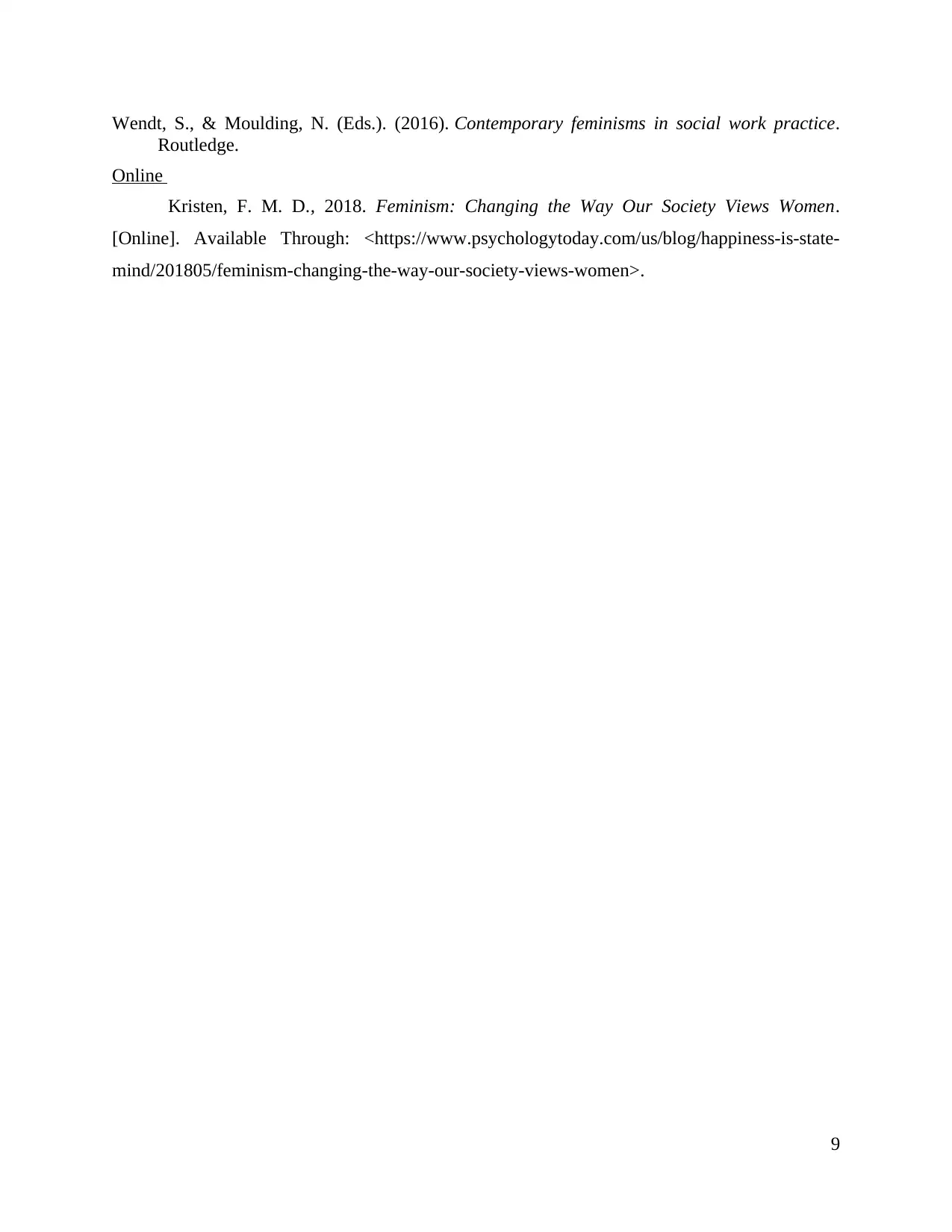
Wendt, S., & Moulding, N. (Eds.). (2016). Contemporary feminisms in social work practice.
Routledge.
Online
Kristen, F. M. D., 2018. Feminism: Changing the Way Our Society Views Women.
[Online]. Available Through: <https://www.psychologytoday.com/us/blog/happiness-is-state-
mind/201805/feminism-changing-the-way-our-society-views-women>.
9
Routledge.
Online
Kristen, F. M. D., 2018. Feminism: Changing the Way Our Society Views Women.
[Online]. Available Through: <https://www.psychologytoday.com/us/blog/happiness-is-state-
mind/201805/feminism-changing-the-way-our-society-views-women>.
9
1 out of 11
Related Documents
Your All-in-One AI-Powered Toolkit for Academic Success.
+13062052269
info@desklib.com
Available 24*7 on WhatsApp / Email
![[object Object]](/_next/static/media/star-bottom.7253800d.svg)
Unlock your academic potential
Copyright © 2020–2025 A2Z Services. All Rights Reserved. Developed and managed by ZUCOL.





